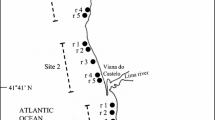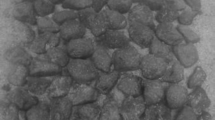Abstract
There exists on Heron Reef, at the southern end of the Great Barrier Reef, an 8-species guild of ecologically very similar, territorial, herbivorous reef fishes. All individuals of these species maintain territories on rubble substrata throughout juvenile and adult life. Territories are defended from all other guild members. Three rubble patches, each containing residents of 3 guild species: Pomacentrus apicalis, P. wardi, and Abudafduf lachrymatus, have been monitored for 12 to 18 months. This paper examines the patterns of use of space as shown by the antecedent and subsequent histories of sites chosen by 43 new colonists, and sites vacated through the loss of 34 residents on the rubble patches. In addition, variation through time is examined in the total amount of space held in territories on each rubble patch. The 3 species show similar preferences for space as colonists, although adult and juvenile colonists behave differently. Numbers of colonists detected on rubble patches are not proportional to the resident populations of the 3 species. Residents of the 3 species are equal in their abilities to enter spaces vacated through mortality, although they differ slightly in methods used to enter sites. They do not respond preferentially to sites previously occupied by any particular species. P. wardi shows a higher rate of mortality than the other species, and residents of this species are more often dislodged by new colonists. The total amount of space held on any rubble patch did not vary during the year from September, 1972 to October, 1973. The data are interpreted as supporting the hypothesis that the 3 species do not differ in their requirements for space on rubble patches, and that they are in competition for a short supply of such space. Differences exist in their strategies for obtaining and holding such space. These differences are important for explaining the continued presence of P. wardi on rubble patches. P. apicalis and a. lachrymatus are both specialists in holding territories on the upper reef slope. No differences have been detected in their requirements or competitive abilities. P. wardi is a fugitive species on the upper reef slope, coexisting because it maintains a refuge from competition by occupying some un-preferred sites off rubble patches.
Similar content being viewed by others
Literature cited
Fischer, A.G.: Latitudinal variations in organic diversity. Evolution, Lancaster, P.A. 14, 64–81 (1960)
Hutchinson, G.E.: Concluding remarks. Cold Spring Harb. Symp. quant. Biol. 22, 415–427 (1957)
Keenleyside, M.H.A.: The behaviour of Abudefduf zonatus (Pisces: Pomacentridae) at Heron Island, Great Barrier Reef. Anim. Behav. 20, 763–775 (1973)
Low, R.M.: Interspecific territoriality in a pomacentrid reef fish, Pomacentrus flavicauda Whitley. Ecology 53, 648–654 (1971)
MacArthur, R.H.: Patterns of communities in the tropics. Biol. J. Linn. Soc. 1, 19–30 (1969)
Pianka, E.R.: Latitudinal gradients in species diversity: a review of concepts. Am. Nat. 100, 33–46 (1966)
Root, R.B.: The niche exploitation pattern of the blue-gray gnatcatcher. Ecol. Monogr. 37, 317–350 (1967)
Sale, P.F.: Influence of corals in the dispersion of the pomacentrid fish Dascyllus aruanus. Ecology 53, 741–744 (1972)
—: Mechanisms of co-existence in a guild of territorial fishes at Heron Island. In: Proc. 2nd Int. Symp. coral reefs, Vol. 1, pp 193–206 Brisbane: Great Barrier Reef Committee 1974
Smith, C.L. and J.C. Tyler: Space resource sharing in a coral reef fish community. Bull. nat. Hist. Mus. Los Angeles Cty 14, 125–170 (1972)
Author information
Authors and Affiliations
Rights and permissions
About this article
Cite this article
Sale, P.F. Patterns of use of space in a guild of territorial reef fishes. Mar. Biol. 29, 89–97 (1975). https://doi.org/10.1007/BF00395530
Accepted:
Issue Date:
DOI: https://doi.org/10.1007/BF00395530




